Статьи журнала - International Journal of Wireless and Microwave Technologies
Все статьи: 454

Статья научная
In this paper, we present atmospheric effect on 5th Generation (5G) millimeter wave (MMWave) communication system. Atmospheric effects for Delhi (India) based 5G communication system is calculated as per Delhi atmospheric conditions. Atmospheric impairments are major cause of degrading mmWave signal power while mmWave propagation in wireless channel. Due to Atmospheric impairments attenuation takes place and major impairments are like water vapour, oxygen, rain and fog for Delhi (India). 5G mmWave attenuation calculations are performed for the mmWave band frequencies 28 GHz, 37 GHz and 39 GHz. In this paper intelligent adaptive transmitter based on trend of the atmospheric conditions tunes to machine learning (ML) based derivation of channel capacity. The ML based transmitter is a supervised ML device and it has provision of self teaching learning machine based on data. Results are graphed for the mentioned frequencies and also intelligently software defined (SD) Shannon channel capacity calculated for Delhi (India) based 5G mmWave communication system under different atmospheric conditions.
Бесплатно
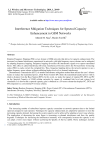
Interference Mitigation Techniques for Spectral Capacity Enhancement in GSM Networks
Статья научная
Random Frequency Hopping (FH) is a key feature of GSM networks that allows for capacity enhancement. The increased co-channel interference experienced in networks with tight frequency reuse schemes can be mitigated by adopting frequency hopping. Frequency hopping diversifies the interference signals over sparse transmitted bursts. This effect is called Interference Diversity. Interference Diversity allows the Forward Error Correcting codes (FEC) to easily correct the corrupted bits. Thus, frequency hopping allows the network operator to use a tighter frequency reuse scheme without exhibiting higher levels of co-channel interference. Discontinuous Transmission (DTX) is another interference mitigation method that utilizes the user’s silence frames to reduce the transmitted power, while Power Control (PC) links the transmitted handset power with its relative distance from the Base Station (BTS). In this work, we study the impact of random FH, DTX and PC on the Spectral Capacity of GSM cellular networks by means of combined link level and system level simulation. It is shown that a spectral capacity gain is obtained in a 3/9 reuse scheme that deploys PC, DTX and FH compared to a conventional 4/12 reuse scheme.
Бесплатно
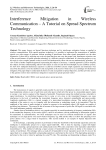
Interference Mitigation in Wireless Communication – A Tutorial on Spread Spectrum Technology
Статья научная
This paper focuses on Spread Spectrum technique and its interference mitigation feature as applied in wireless communication. With spread spectrum technology it is possible to implement the transmission of multiple signals over wider ranges of spectrum without resulting to interference from other signals transmitted over the same frequencies. It does this by rejecting any received signal that does not carry the proper code. Interference rejection, one of the several features of spread spectrum technology is a difficult concept to understand. It is therefore proper to x-ray this topic in a less complex manner so that it can be well understood by those who are not mathematically grounded. In view of this a further simplified approach in presenting this subject is necessary. A tutorial approach is used to simplify this subject for better understanding and how this feature is used in Code Division Multiple Access (CDMA) systems. To show how multipath interference rejection is achieved in CDMA systems simple equations and schematics were used. The discussions cover the method of code recognition at the receiver which serves as a technique for interference mitigation. The paper helps to understand the theory of code recognition in Spread Spectrum, and thus provides answer to the question on how does interference mitigation or rejection in spread spectrum works?
Бесплатно

Interference mitigation and mobility management for D2D communication in LTE-A networks
Статья научная
Interference and Mobility management are the main parameters which affect the signal capacity and reduce the transmission efficiency for D2D communication in LTE-A networks. When the users are in the same spectrum, due to the coexistence of D2D pairs and cellular users interference management becomes a critical issue. In this paper, we introduce an interference management algorithm that maximizes the performance of D2D communication in LTE-A networks for both uplink and downlink transmissions. Optimal routing selection techniques reduce the total path distance which helps to minimize the interference and improve the overall network capacity. Mobility management is also a challenging issue in IP-mobile networks. When two DUEs change their locations from one BS to the other, handover delay calculation becomes very important to maintain the communication without interruption. In this paper we show power control techniques which helps to reduce the effect of interference and also we addressed a method for the lower delay under complex mobility issues with uninterrupted D2D communication.
Бесплатно
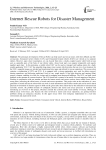
Internet Rescue Robots for Disaster Management
Статья научная
The prototype development of Rescue Robot can help search and rescue teams with their difficult and life-saving tasks. Unmanned Aerial vehicles (UAVs) and Unmanned Ground vehicles (UGVs) are viewed as two separate entities. However, upon closer examination, we can classify them into a closely-coupled system where both are just seen as separable parts of the body of one robotic entity, whose body parts can separate temporarily and acquire together again later. In this prototype, a mobile robot UGV can be used as transport and landing station for a light-weight quadcopter UAV. UAV has separable long-range vision system which provides the top view of environment for the UGV, separable images are stitched and transformed into maps and utilized for rescue operations. This rescue robot contains a combination of UGV and UAV. It is equipped with a strong manipulator arm, used for debris removal, shoring operations, and delivering medicines/ food on very rough terrain. It has light detection and ranging (lidar) sensors, cameras, enabling it to look for victims and for mapping semi-destroyed buildings. The UGV can send visual feedback to the operator at a remote location. The UAV drone has a camera for an aerial view and mapping of the place. Working in conjunction with one another and thus the human search and rescue workers, these robotic assets form a strong team, increasing the effectiveness of search and rescue operations. This project aims at the realization of a new generation of search and rescue robot which can work in semi-autonomous and wireless modes and can be used in harsh physical environments of disaster regions to hold out the given tasks more effectively by the utilization of advanced and economic sensors. the problem domain of earthquake disasters and search and rescue processes is clarified with introducing an overview of this project. Disasters unsettle the economic and social stability of society. Shortage of skilled rescue work forces, also because the risks involved in search and rescue operations, are getting foremost problems during an emergency situation. In this paper rescue robot were designed, implemented in a real time environment and analyzed the result.
Бесплатно

Interoperability in connected vehicles – a review
Статья научная
The introduction of automated transportation system and implementation of connected vehicle system has made interoperability even more critical than before in order to ensure effective connectivity , consistency , accuracy and reliable performance.Connected vehicles are employed with in vehicle sensor networks to collect , store , process and communicate with neighbouring vehicles to help drivers making life saving decisions. Connected vehicle systems enable the exchange of communication between a vehicle and world. Some vehicles may only receive communication, other vehicles may only send data and some may receive and send data. Hence it is essential that all systems , devices need to work together in a safe, trusted , efficient manner. Devices/Sensors embedded in vehicles follow different communication protocols as the sensors or devices are manufactured by different vendors. Hence management of coordination between devices is of much importance in Dynamic, Mobile, Heterogeneous environments such as connected vehicles. Hence, there is a need to create seamless interoperability to enable connected vehicles. It is required to enable intelligent transportation system (ITS) system/devices in Vehicles to effectively connect and communicate with other systems/devices. The adaptability of Interoperability when the devices are adhere to dynamics and mobile in nature becomes tedious and cumbersome. Solutions to interoperability is not much explored in literature. Existing interoperability solutions does not guarantee to articulate for high mobile environments such as connected vehicles where vehicles are highly mobile in nature and moving at varying speeds. The paper summarizes connected vehicles issues and challenges, current interoperability solutions, the impact of interoperability in connected vehicle scenario and demonstrates the effect of conversion time delay when exchanging data between source and destination pairs.
Бесплатно

Статья научная
The wireless sensor networks are most important developers of machine-to-machine communication (M2M) networks. In each node of sensor, transmission power is the most important energy consumption factor, which is considered as the most important challenge for expansibility of M2M network. One strategy to cope with this problem is topology control algorithm. This algorithm consists of two topology design and topology maintenance phases. The focus of most works conducted in this field is on design topography. However, topology maintenance should be also considered during the topology control design. To prolong network life through the energy consumption management in the nodes, in this paper an algorithm is proposed which considers both topology design and maintenance. The simulation results obtained using NS-2 simulator prove innovation and higher performance of the proposed model.
Бесплатно
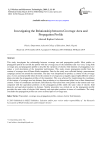
Investigating the relationship between coverage area and propagation profile
Статья научная
This study investigates the relationship between coverage area and propagation profile. Most studies on propagation profile do not link the profile with the coverage area of the transmitter and vice versa. Using both coverage area and propagation profile to describe the variations of electric field intensity of propagating wave makes a vivid description of the transmitter performance. This study creates propagation profile from the contour of coverage area of Benue Radio transmitter. Data for the study were collected during a measurement campaign carried out around the transmitter. The data were interpolated to produce a contour of the coverage area. A cross sectional profile elicits from the contour of coverage area at equally spaced eight different vertical plains provides the propagation profiles of the transmitter. This was achieved by transforming the coordinates of the contour of coverage area into distance thus producing a two dimensional plain from a three dimensional contour. Values of coordinates and electric field intensity were taken from some points on the contour and were compared with the equivalent positions on the propagation profile yields the same value of electric field intensity and equivalent position in distance. Similar procedure was carried out on the propagation profile provides the same value of electric field intensity and equivalent positions in terms of coordinates. The study concludes that propagation profiles are cross sectional parts of coverage area.
Бесплатно
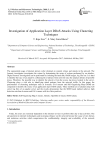
Investigation of application layer DDoS attacks using clustering techniques
Статья научная
The exponential usage of internet attracts cyber criminals to commit crimes and attacks in the network. The forensic investigator investigates the crimes by determining the series of actions performed by an attacker. Digital forensic investigation can be performed by isolating the hard disk, RAM images, log files etc. It is hard to identify the trace of an attack by collecting the evidences from network since the attacker deletes all possible traces. Therefore, the possible way to identify the attack is from the access log traces located in the server. Clustering plays a vital role in identifying attack patterns from the network traffic. In this paper, the performance of clustering techniques such as k-means, GA k-means and Self Organizing Map (SOM) are compared to identify the source of an application layer DDoS attack. These methods are evaluated using web server log files of an apache server and the results demonstrate that the SOM based method achieves high detection rate than k-means and GA k-means with less false positives.
Бесплатно

Investigations with All Optical Binary Subtractor Network at 100Gbps
Статья научная
This article demonstrates for the proposed all optical binary subtractor network. Performance explored by exploiting nonlinear attribute the cross gain modulation with semiconductor optical amplifier which otherwise considered as cons if used as an amplifying tool. Numerical simulations have been executed, accordingly accustomed data inputs at 100Gbps data rate employed, generated aspired difference and the borrow outputs concurrently. The design’s performance for the non return to zero, return to zero and Manchester modulation formats have been analyzed, according to it is key performance parameter the extinction ratio. Investigations inferred optimum performance for the non return to zero modulation format outcome extinction ratio of 13.5dB,together with difference and borrow output have been successfully confirmed. Further designs execution with non return to zero modulation format for the key parameters range of data rates, laser peak power, the normalizer power, pump current, the current injection efficiency and the modulator bias voltage have been evaluated. Evaluation inferred that optimum performance is subject to the pertinent election of the vital design parameters. The proposed design is simpler by virtue of key attributes low power consumption and stability altogether with higher integration capability as well provides output generation simultaneously at higher data rate. It was lacking with preceding elucidations. Accordingly, this illustration could be an assistance towards novel contemporary complex digital optical computing combinational networks.
Бесплатно
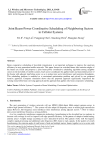
Joint Beam-Power Coordinative Scheduling of Neighboring Sectors in Cellular Systems
Статья научная
Beam cooperative scheduling of downlink transmission is an important technique to improve the spectrum efficiency in next generation mobile networks. This paper focuses on switched beams (the emission angles of the beams are fixed) and proposes a joint beam-power coordinative scheduling algorithm among neighbor sectors in the downlink of mobile systems. Each sector coordinates the applied order and transmitted power of the beams with adjacent interfering sector, so as to reduce inter-sector interference and maximize throughputs. This scheduling problem is modeled as a constrained optimization problem and solved by our proposed iterative approach. Computer simulation shows that the proposed approach significantly outperform the existing round robin beam servicing approach and the approach that applies only beam cooperative scheduling.
Бесплатно

Keywords Review of IT Security Literature in Recent 20 Years
Статья научная
The volume of published scientific literature available on Internet has been increasing exponentially. Some of them reflect the latest achievement of the specific research domain. In recent years, many projects have been funded aiming to online scientific literature mining, especially in biomedical research. Scientific literature covers most of the hot topics in the research field and has a very large domain-specific vocabulary. The exploitation of domain knowledge and specialized vocabulary can dramatically improve the result of literature text processing. The purpose of this paper is to identify the frequently used keywords in IT security literatures. The result then can be utilized to improve the performance of automatic IT security document retrieval, identification and classification. Our method is to query CiteseeX to retrieve source data of paper description information and build an artificially annotated corpus. Over the corpus, we perform words frequency statistics, word co-occurrence analysis, discrimination index computation, retrieval efficiency analysis and thus build a lexicon of IT security based on our experimental result. The lexicon can further be used in improving retrieval performance and assisting new words discovering and document classification.
Бесплатно
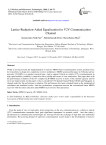
Lattice-reduction-aided equalization for V2V communication channel
Статья научная
World is moving towards the implementation of massive MIMO based communication system and that forces the researchers to design low complexity receiver architecture. MIMO system performance in Vehicular ad hoc networks (VANETs) is a popular research topic. And to support Vehicle-to-vehicle (V2V) communication in high speed mobility condition, it required to have reliable and secure of com-munication. This paper deals with the performance evaluation of the low complex LLR-MMSE receiver in terms of the channel capacity and bit error rate improvement. In this paper we have considered V2V Spatial Channel Model (SCM) and Nakagami-m chaneel model for the performance evaluation. The performance has been evaluated based on the mathematical calculation and simulated results. And also performance comparison between the conventional linear MIMO receivers with the lattics reduction aided MIMO receivers have been presented.
Бесплатно

Статья научная
Forgetting the stipulated schedule or time of lectures due to one reason or the other has always been a major concern for students resulting in the students missing classes and thereby lagging behind in what the lecturer has taught the other students. The main purpose of developing the Lecture time table reminder system is to minimize this problem to an acceptable level. Lecture Timetable Reminder System is a mobile application developed on the Android platform for the students of Computer Science, 500level, Federal University of Technology, Akure, with the service of reminding them about their lectures. The major tools used in developing this application are Java, Eclipse, Android Software Development Kit (SDK), PHP and MySQL. Java is the programming language that was used and Eclipse is the Integrated Development Environment (IDE) and Android SDK is a virtual device emulator. Then PHP was used to produce a response customized for each user's request to the application, MySQL is the database.
Бесплатно
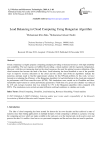
Load Balancing in Cloud Computing Using Hungarian Algorithm
Статья научная
Cloud computing is a highly popular computing paradigm providing on-demand resources with high reliability and availability. The user requests are fulfilled by providing a virtual machine with the requested configuration. However, with the ever-increasing load on the cloud resources, the need for optimal resource utilization of the cloud resources has become the need of the hour. Load balancing has been identified as one of the possible ways to improve resource utilization in the cloud and the current state-of-the-art algorithms indicate the numerous attempts made to find the approximate solution for this NP-hard problem. In this work, we have focused on evaluating the efficiency of the Hungarian algorithm for load distribution in the cloud and compared its performance with First-come-first-serve (FCFS). The simulations were carried out in CloudSim and show remarkable improvement in various performance parameters. Finish time of a given task schedule was reduced by 41% and average execution time was reduced by 13% in the Hungarian algorithm when compared with FCFS. The simulations were carried out under different workload conditions to validate our results.
Бесплатно
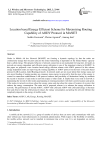
Location based Energy Efficient Scheme for Maximizing Routing Capability of AODV Protocol in MANET
Статья научная
Nodes in Mobile Ad hoc Network (MANET) are forming a dynamic topology by that the nodes are continuously change their location and also the nodes functioning is dependent on the limited battery capacity that is called energy. The dynamic behavior of network connection is not maintained for long time. All nodes in network are energy dependent and efficient energy utilization is one of the important criteria in MANET. In this paper we proposed a new location based energy efficient scheme with AODV protocol. In this scheme energy dependent nodes are improving the routing capability of AODV protocol on the basis of location based protocol LAR (Location Aided Routing protocol). In network nodes are not aware about their energy status and also recur flooding of routing packets are consumes more energy in network by that the most of the energy is wasted in connection establishment. LAR protocol reduces that possibility of destination finding by maintain the record of location of each node in network respect to other nodes. It implies that every node in network is maintaining the record of other nodes (participating in routing procedure) with their current location and speed. If the nodes in network are know about the energy status and also about the status of location of receiver that reduces the energy consumption. The main aim of proposed scheme is to enhance the energy utilization in network. The performance of normal AODV, AODV with LAR and AODV with LAR and Energy is illustrate here and observe that the LAR protocol reduces the energy consumption and prolog the network lifetime that completely depend on the energy of mobile nodes.
Бесплатно
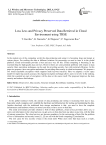
Loss Less and Privacy Preserved Data Retrieval in Cloud Environment using TRSE
Статья научная
In the modern era of the computing world, the data producing and using it is becoming large and instant at various places. For availing the data at different locations for processing we need to store it in the global platform. Cloud environment provides a best and easy way for this. Cloud computing is becoming as the essential thing for high-quality data services. However there are some potential problems with respect to data security. Here encryption techniques can be used for providing security, but with restricted efficiency. In this paper we propose a new encryption mechanism for providing data security in cloud environment. We propose a two round searchable encryption which supports multi keyword retrieval. Here we adapted a vector space model for improving search accuracy; the elgamal encryption technique allows users to involve in the ranking, while the essential key part of encryption will be done at the source itself. The proposed improves the data security and reduces data leakage.
Бесплатно
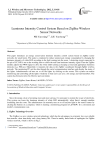
Luminous Intensity Control System Based on ZigBee Wireless Sensor Networks
Статья научная
This paper introduces an energy conservation luminous intensity control system based on ZigBee sensor networks for smart home. The study is conducted to reduce unnecessary energy consumption by changing the luminous intensity of white LED according to the light coming into the room. A detecting circuit connected to the pin of CC2430 is set on the working face to collect the real-time luminous intensity signal. Then the ZigBee module adjusts the PWM signal to drive the white LEDs aiming at keeping a fixed and appropriate luminous intensity (e.g. 500Lux). Meanwhile, it transmits the data to the ZigBee coordinator through ZigBee wireless network. The monitoring PC get the data through the serial communication interface and display the states of the lights. Administrators can turn on or off the lights by clicking on the screen. This system can realize monitoring and controlling all the lights wirelessly so that users can save a lot energy and staff members. The system has been proved to be effective and convenient.
Бесплатно

MANET testbed using raspberry PIs
Статья научная
Mobile ad-hoc networks (MANETs) are without any infrastructure and consists only of equal peers. This paper presents an empirical tests for MANET routing protocols. The testbed based on Linux platform installed in mobile computers. Some parameters are analyzed such as movement speed and the number of hops which impact on routing performance. The testbed consists of several Raspberry Pis (RPis) without the need for any central master device. For making the RPis mobile and independent of any fixed power sockets, each of them is powered by a battery. On the other hand, for the evaluation of the testbed, two routing protocols are chosen. The first protocol is called BABEL, which considered as a distance vector routing algorithm. The other one, the Optimized Link State Routing Protocol (OLSR) which considered as proactive routing protocol. The use case was a multi-hop download of files with different size. The aim is to evaluate how multiple hops influence the bandwidth and delay. The results show that OLSR performs better regarding the throughput. But Babel has less delay and faster regarding convergence.
Бесплатно
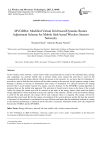
Статья научная
In the wireless sensor network, various sensor nodes are present that are used for the communication, sensing and computing. An external mobile sink is present which move around the grid that is used for the communication with the nodes directly which are present in the network. As we know that for formation of network we need to find the route between all the nodes coming in the network, for this purpose routing is done. Routing is defined as moving of information from source to destination. For efficient network the routing protocol that is used should consume less energy, and less distance. In the MVGDRA routing algorithm is proposed that use the mobile sink approach. The selection of cluster head is done on the basis of the weight values. By doing this cluster head will be selected on the basis of the energy means which node has highest energy appointed as cluster head that increases the stability of the network. And the event driven based strategy is used for the data transfer, the energy will be only released when it is required. The energy will not be released after each round. By this the energy consumption of the system decrease and the life time the network is increased. So this method is considered to be more efficient and better than the traditional methods of routing as the network performance is enhanced and its life time is increased. Simulation results show the comparison between the VGDRA and the MVGDRA.
Бесплатно

